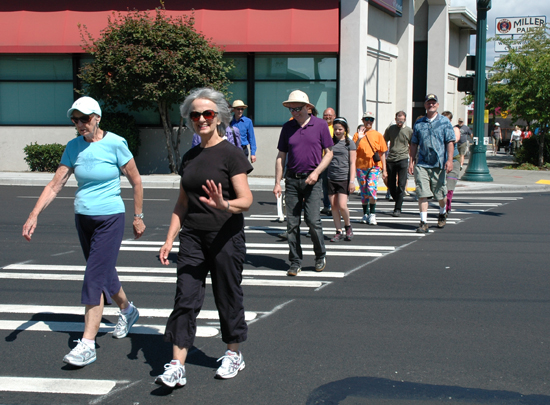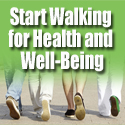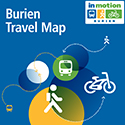by Maureen Hoffmann, WABI Burien President
Small steps. That’s all it takes to start a walking program toward greater health and a sense of well-being. For just the cost of comfortable walking shoes and a little time, you can go for a walk, get the kinks out, clear the cobwebs, change your outlook and have a body that feels and functions better.
You can start out “low and slow” with fewer steps and an easier pace, then build up to the recommended 10,000 steps a day. (The average American walks 3,000 – 4,000 steps a day.) As you integrate more walking into your daily routine, you’ll begin to look forward to your striding time. Your heart rate will pick up; you’ll breathe deeply and you’ll feel greater ease. You’ll be convinced that stepping out for a walk is one of the best things you do for yourself, (and you’ll be right).
Not only will your body feel better overall, but your brain will be healthier, too! As we face the diseases that too often accompany aging, a walking program may be the best prescription of all.
… if physical activity helped to mold the structure of our brains, then it most likely remains essential to brain health today, says John D. Polk, an associate professor of anthropology at the University of Illinois at Urbana-Champaign, and co-author, with Dr. Raichlen, of the new article. And there is scientific support for that idea. Recent studies have shown, he says, that “regular exercise, even walking,” leads to more robust mental abilities, “beginning in childhood and continuing into old age.” – “Exercise and the Ever-Smarter Human Brain”, by Gretchen Reynolds, New York Times, December 26, 2012
Take a look at some of the tips and resources listed below, then put on some comfortable shoes and go for a walk. Your starting point may simply be just walking around the block, and if that’s the case, still give yourself a pat on the back for making that loop. You’ve just taken the first steps toward a lifetime habit that will increase your health and well-being.
Please remember: If you’re “a little rusty in the exercise department”, it’s important to see your health care provider before starting a new fitness program if you are overweight or have health issues.
Use a Pedometer:
- Measure your “typical” number of steps per day, then consider adding 500 to 1000 steps per day.
- Set and track your walking goals.
- Feel motivated and watch your progress.
- Every step counts!
Benefits of walking:
- Stress reduction and greater sense of well-being
- Reduced risk of coronary heart disease, stroke, type II diabetes, breast and colon cancer and other chronic diseases
- Weight control. A 200 lb. person walking at 3 mph burns 106 calories per mile. (See chart for further figures.)
- Improved bone density: low-impact yet weight-bearing exercise
- Inexpensive: No fancy equipment needed
- Portable: You can walk wherever you happen to be, even when traveling
- Lower health care costs
- Improved quality of life
Walking improves your body’s daily functions:
- Circulation
- Sleep
- Spinal health and flexibility
- Digestion
- Brain health
- Muscle tone
- Body temperature regulation
How to add walking to your day:
- Use a pedometer and wear it all day. Count your steps.
- Take the stairs instead of the elevator or escalator.
- Park at the outer edge of the parking lot and walk that distance in to the store.
- Park your car in one centralized location and walk to each shop/business you need to visit (instead of moving your car each time).
- Break your walk into several smaller chunks, such as three 10-minute mini-walks.
- Walk around the block during your lunch break.
- Find a walking partner with whom to share conversation while you’re strolling. Form a walking group.
- Walk, when you would normally drive a car.
- Take family walks after dinner.
- Become a “Mall Walker” and walk rain-or-shine. Many shopping malls have a regular crowd of walkers.
- Vary your walking route. You’ll discover things you never see while driving a car.
Walker’s resources
- Beginner’s Walking Schedule: About.com – Goals, building a habit and schedule
- Walking for Beginners: About.com – Preparation, technique, schedule, resources
- Walking Strategies for Overall Health: VeryWellFit.com
- Calories Burned While Walking: About.com – How to estimate calories burned while walking.
…And of course, many of the same benefits of walking also apply to cycling!





